by Mike Schantz, Friends Advocacy Committee
|
by Mike Schantz, Friends Advocacy Committee
|
David was there when Friends was created at a meeting at the Kenai Refuge in 2005. He volunteered to be the first president and has been the only president for all but two years of our history. During his tenure, Friends grew from an organization of a few dozen people to the 315 members we have today. Our volunteer, advocacy and education programs have increased exponentially under his leadership.
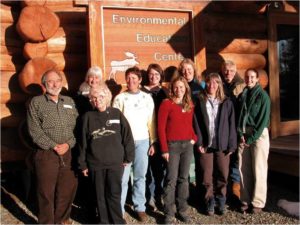
David (on left) at the founding of Friends in 2005 at the Environmental Education Center at the Kenai National Wildlife Refuge. pc.USFWS
In his advocacy work, David has attended many meetings with the Alaska Congressional delegation, testified before Congress and at public meetings in Alaska, submitted many beautifully written and persuasive comment letters on refuge planning documents and issues under review and formed alliances with other conservation partners. He was the author of advocacy column in this newsletter which sought to keep all of us up to date on refuge issues. Principal issues he was engaged in included proposed oil and gas development in the Arctic Refuge, the proposed road through Izembek Refuge and a proposed gutting of Kenai Refuge regulations. He made a point of visiting many of Alaska’s 16 refuges and cultivated relationships with Fish and Wildlife staff in the Anchorage regional office and on individual refuges. David’s first-hand knowledge of refuge lands and the people responsible for managing them, increased our effectiveness in advocacy and support of the Refuges.
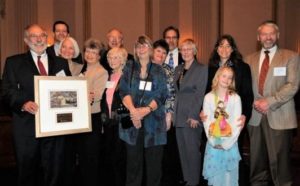
David (on left) receiving the Outstanding Friends Group of the Year Award in 2010 in Washington D.C. from the National Wildlife Refuge Association. David’s wife Marga is next to him and founding “mothers” Sharon Baur, Ginny Harris, Betty Siegel and Patricia Wood. Then Secretary of the Interior Ken Salazar is behind Ginny. pc:USFWS
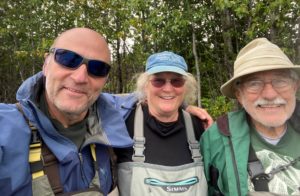
We as a Board will miss the wise counsel and deep knowledge that David has contributed to our work for the last 18 years. His passion for wildlife refuges and the success of the System in Alaska has been an inspiration to us all.
Thank you David!
Alaska’s Resource Protection Teams: Patrol Captain/ Canine Handler Rob Barto with Eider and Senior Federal Wildlife Officer/ Canine Handler Pete Harvey with Togo. pc. Lisa Hupp
Imagine you are a Federal Wildlife Officer on a very busy National Wildlife Refuge. You just received a call from a concerned citizen stating they heard gunshots near a refuge lake while they were observing nesting migratory birds. The bird watcher stated they saw a huge flock of birds leave their nests as soon as the shots were fired. When the flock cleared, three birds lay motionless on the ground. It was not hunting season.
You respond to the area and try to locate the individuals responsible, but they are gone. So begins your investigation. The large lake is surrounded with high grasses. You follow a trail of flattened down grass to an area where it looks like someone had laid down. You search in vain through the grass to try and locate any shell casings or other evidence. Where do you go from here?
You know that the U.S. Fish and Wildlife Service (USFWS) has nine Resource Protection Canine Teams throughout the country, and one of the teams is located in your area. You call up the team and ask for their assistance.  Eider ready to go to work,. pc: Lisa Hupp
Eider ready to go to work,. pc: Lisa Hupp
This is where Federal Wildlife Canine Togo or Eider and their handlers Peter Harvey and Rob Barto come in. We are certified as Resource Protection Teams. This means Togo and Eider can detect illegally taken wildlife (currently certified in caribou, moose, brown bear and black bear detection), locate evidence of illegal activity (casings, knives, bullet fragments, etc.), track for missing persons, and help apprehend dangerous and violent offenders. Togo and Eider are one of the very few K-9s in the world that are trained for wildlife detection AND handler/public protection.
In this scenario, we would be able to use Togo and Eider’s unique ability to locate “articles” or “evidence” that has human odor. For instance, they would be able to locate any shotgun shells or rifle casings. Both canines are trained to perform a specific function that alerts us to when they have located evidence with human odor. Such evidence could be used in either our or other officer’s investigations.
Both teams are based on the Kenai National Wildlife Refuge but work throughout the state. In addition to the Kenai, the K9s have worked on the Yukon Delta and Tetlin Refuges and assisted the BLM during caribou hunting season along the Steese and Taylor highways. They have participated in search and rescues and duck, moose and caribou hunter law enforcement. In one case with a happy ending, Pete got a call about a hunter harvesting a sub legal moose. Togo was sent out and quickly found the car but the harvested moose turned out to be legal! Both dogs live with their handlers in kennels but not as house pets.
Federal Wildlife Canine Togo was born in the Czech Republic and came to Alaska after training in Pennsylvania. Togo and Pete got to work in August of 2022. Togo got his name from the famous dog team that carried lifesaving medicine to the town of Nome, Alaska, during the 1925 Serum Run. He enjoys being active outdoors, hiking, swimming and eating milk-bones. Federal Wildlife Canine Eider is a four-year-old German Shepard and Belgian Malinois mix. He came from Belarus and was trained in Michigan in 2020. Eider was the first FWS K9 certified for both wildlife detection and handler protection. 
Meet the Dogs
Do you want to see these dogs in action? Come to our indoor/outdoor presentation at the Kachemak Bay Shorebird Festival in Homer, Saturday May 6, 2 pm for adults and 4:30 pm for Junior and Teen Birders. You must register because space is limited, but you can do that online here.
by David Raskin, Friends Board President
|
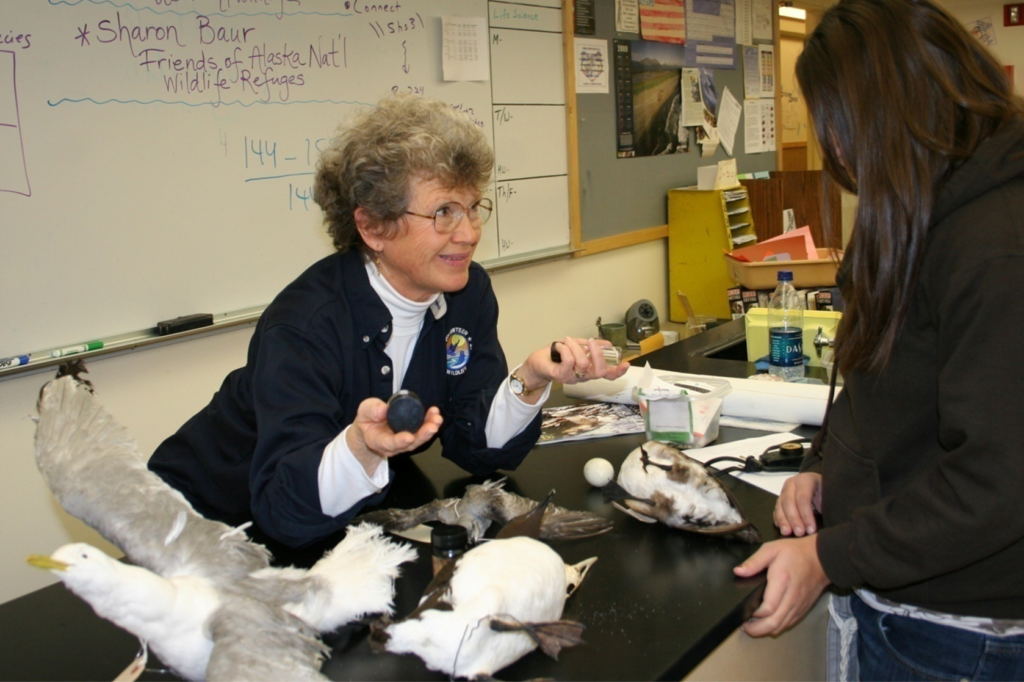
Friend Sharon Baur teaching at the Shorebird Festival; pc: USFWS
Teaching in Arctic Village; duck banding in Tetlin, maintenance at Galbraith Lake and on the Kwethluk River, event planning, spring clean-ups, hosting an art show, showing kids the great outdoors and reaching out to the public – the refuges are asking for our help in a big way! Refuges from Alaska Maritime to the Yukon Delta have come back from the pandemic drought in volunteer projects to requesting our help with more than 15 projects. Most of these are now posted on our Volunteer Page along with the Volunteer Application.
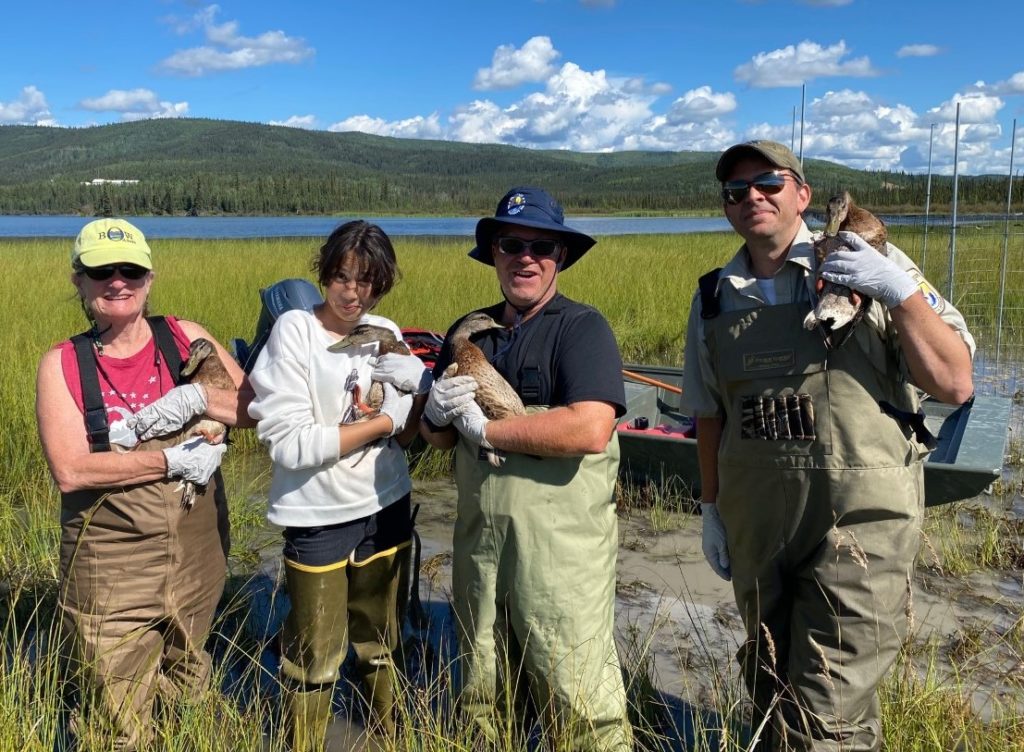
Friends duck banding on Tetlin Refuge in 2022; pc: USFWS
Please consider donating some time to help a refuge this year. You could make a big difference. Projects range from a 10 day commitment at Izembek to a two hour shift at an outreach table in Homer, Soldotna, Kodiak, or Fairbanks. How about spring in Homer at the Kachemak Bay Shorebird Festival, May 3 to 7. Friends cosponsors the Festival and we need volunteers as bird guides, Friends outreach table, event help and much more. If you are in Anchorage or Fairbanks, help is needed for outdoor schools for upper elementary children. Opening a child’s eyes to nature is really our only hope for the future of wild places and wildlife. The outdoor schools are coming up quickly as well. Closing dates for applications vary but some are as soon as March 30.
There truly is something for everyone in our project list. In addition, both the Kenai and the Alaska Maritime Refuge will have projects not yet listed that will need help throughout the year. Watch for those. For more information go to the Volunteer Page or contact us at volunteer@alaskarefugefriends.org.
by David Raskin, Friends Board President
Arctic Refuge
Trustees for Alaska and the Native Village of Venetie filed reply briefs in support of Department of Justice (DOJ) on February 17, 2023. DOJ had previously filed its opposition to the plaintiffs’ motion for summary judgment in the federal lawsuit by the Alaska Industrial Development and Export Authority (AIDEA) and the State that challenged the moratorium on oil and gas development in the Coastal Plain. Friends had intervened along with many conservation organizations and Tribal governments on behalf of the Biden administration. AIDEA and the State must file their reply brief by March 20. AIDEA also requested oral argument, which the court will likely schedule after their reply brief is submitted.
On February 8, 2023, the Fish and Wildlife Service (FWS) filed a Federal Register notice regarding the preparation of an Environmental Assessment (EA) for the December 2021 SF 299 application by Kaktovik Inupiat Corporation (KIC) for a winter right-of-way (ROW) across the tundra in a wilderness study area. The draft EA is scheduled for September 2023 followed by a public comment period. The permit will require compliance with the Marine Mammal Protection Act regarding potential impacts on polar bears and a full Environmental Impact Statement process may result in a requirement for an incidental take permit, which could become a major problem for the ROW application. It should be noted that the request for a winter right-of-way across the Refuge may have implications for Alaska National Interest Lands Conservation Act (ANILCA) and the Izembek road controversy.
A draft report on the Kaktovik claim of historical vehicle use for subsistence activities in the Arctic Refuge tundra, including wilderness study areas, is still under review. Under the solicitor’s opinion in the previous administration, the Refuge is open to motorized vehicles, but there has been little activity to date.
Izembek Refuge
On December 13, 2022, the Ninth Circuit Court of Appeals heard oral arguments in its en banc review of the DOJ and State appeal of our second successful lawsuit that had stopped the illegal land transfer for the proposed Izembek road. The decision to rehear the case en banc nullified the disastrous panel decision and began the road proponents appeal anew. The panel, a majority appointed by Trump, could issue a decision as early as this month. The Izembek coalition is working at all levels of the administration and Congress to convince Secretary Haaland to withdraw the illegal land exchange before Ninth Circuit issues a decision. That is the only way to immediately put an end to the threats to Izembek National Wildlife Refuge and up to 150 million acres of federal conservation lands currently protected by ANILCA.
Kenai Refuge
The Supreme Court on March 6, 2023, denied the State of Alaska’s writ of certiorari that sought a review of the Ninth Circuit’s decision that upheld the District Court decision that supported FWS hunting regulations. This is a great win for the Kenai Refuge, its wildlife, and all who worked so hard to help this happen.
We also received the wonderful news that FWS withdrew the June 11, 2020, Trump administration proposed rule to amend the refuge-specific regulations for Kenai Refuge. Based on the extensive public comments that Friends helped to organize, FWS reviewed the new information provided and determined that the best course of action was withdrawing the proposed rule.
Yukon Flats National Wildlife Refuge
We have heard nothing further on the results of Hilcorp’s shallow exploration on Doyon Corporation inholdings in the Yukon Flats Refuge. There is great concern that this may lead to oil and gas development that could negatively impact the world-class wildlife and fisheries and subsistence resources in the Refuge.
Presented by Dave Atcheson author, fly fisherman, canoeist
3/21/23, 5-6PM
Dave will be in person at the Kenai Refuge with a book signing at 4:30 pm, talk at 5 and reception at 6. A watch party will be at the Alaska Maritime Refuge in Homer with Dave’s books available for purchase.
Come learn about the vast canoe country of the Kenai National Wildlife Refuge with Dave Atcheson, author of the newly released book, Canoeing Yaghanen. Swan Lake and Swanson River canoe trails, just north of Sterling, Alaska, cover over 100 miles with more than 70 lakes, two river systems and portage trails. These routes are a national treasure having been recognized as Water Trails within the National Recreation Trail System. The Swan Lake trails and most of the Swanson River trails are within designated Wilderness, closed to motorized equipment and boats. All you will hear will be loon calls, beaver tail slaps, swans honking and wind in the spruce. Dave will share his images and thoughts on what makes this place so special, its wildlife and waterbirds, incredible trout fishing and of course, how you can plan your own adventure into this wonderful network of wilderness trails and waterways. From easy family weekend trips to weeklong adventures, paddlers of all abilities and ages will enjoy this unique wilderness experience.
 Portages varying in length from a hundred yards to nearly a mile connect the lakes of the canoe system. Dave Atcheson portaging. pc Cindy Atcheson
Portages varying in length from a hundred yards to nearly a mile connect the lakes of the canoe system. Dave Atcheson portaging. pc Cindy Atcheson
Dave Atcheson is an avid canoeist, sports fisher and hunter and has spent much of the last 30 years exploring the Swan Lake and Swanson River canoe systems. Dave writes that the canoe trails are one of his favorite places, not only in Alaska, but anywhere. He also writes that “this still-water wonderland contains some of the finest lake fishing Alaska has to offer.” (from Canoeing Yaghanen) Dave has written for a variety of periodicals from Outdoor Life to Boy’s Life to Alaska Magazine and is a past contributing editor to Fish Alaska. He is the author of the memoir of his commercial fishing days, Dead Reckoning, Navigating a Life on the Last Frontier, Courting Tragedy on its High Seas. He also wrote National Geographic’s Hidden Alaska, Bristol Bay and Beyond and the guidebook Fishing Alaska’s Kenai Peninsula. Dave teaches fly fishing and has run the Kenai Fishing Academy at the University of Alaska Anchorage, Kenai Peninsula College. Originally from upstate New York, Atcheson has traveled all over Alaska and lives in Sterling close to the canoe country.  Dave Atcheson with Kenai River rainbow. pc: Lee Keuper
Dave Atcheson with Kenai River rainbow. pc: Lee Keuper
Canoeing Yaghanen (the Good Land): A Guide to Kenai National Wildlife Refuge’s Swan Lake and Swanson River Canoe Systems was published by Alaska Geographic and is available from their online store here or at the Alaska Geographic bookstores at the Kenai Refuge and Alaska Maritime Refuge Visitor Centers.
by David Raskin, Friends Board President
Arctic National Wildlife Refuge
Izembek National Wildlife Refuge
On December 13, 2022, the Ninth Circuit Court of Appeals heard oral arguments in its en banc review of the appeal by the DOJ and the State of our second successful lawsuit that had stopped the illegal land transfer for the proposed Izembek road. Their decision to rehear the case en banc nullified the disastrous panel decision and began the road proponents appeal anew. We were extremely fortunate to obtain the pro bono services of San Diego expert appellate attorney Jennifer Bennett, who brilliantly argued our case before the 11-judge panel that unfortunately included a majority of six recent appointees by former President Trump. Assuming the panel decision could come as early as late March, the Izembek coalition is working diligently to convince Secretary Haaland to withdraw the illegal land exchange before the Ninth Circuit issues a decision. That is the only way to immediately put an end to potential threats to Izembek National Wildlife Refuge and more than 100 million acres of federal conservation lands currently protected by ANILCA
Kenai National Wildlife Refuge
We have heard nothing concerning the October 27, 2022, State of Alaska writ of certiorari to the U.S. Supreme Court seeking review of the Ninth Circuit’s decision that supported our win in the District Court. The State claims that the case raises questions of “exceptional importance” to states and the Ninth Circuit decision is “unsustainable on the merits.” It is noteworthy that Safari Clubs International did not join the State in this latest appeal. The Supreme Court rejects most petitions for review, and we expect the same in this case.
Yukon Flats National Wildlife Refuge
We have heard nothing further on the results of Hilcorp’s shallow exploration on Doyon Corporation inholdings in the Yukon Flats Refuge. There is great concern that this may lead to oil and gas development that could negatively impact the world-class wildlife and fisheries and subsistence resources in the refuge
by Caroline Brouwer, Friends Board Member
We are dedicating this advocacy report to the current state of Refuge System funding. Refuges across the nation are underfunded to the point of neglect and closure. Here in Alaska, Friends support 16 refuges that make up over 80% of the land acres in the Refuge System. Alaska refuges’ funding needs include climate science research and additional biologists and visitor services staff across all refuges, and additional dollars for maintenance of not just habitat, but infrastructure and roads. But perhaps most importantly, we need staff who can work with our local communities to ensure refuges meet the needs not only of our incredible wildlife, but the people who live near them.
First, a few numbers: there are 95 million land acres in the Refuge System, 80 million of which are in Alaska (84% of the land mass of the Refuge System is in Alaska). There are an additional 750 million acres of vast stretches of ocean – both Pacific and Atlantic – in the refuge system, Alaska is the nursery for songbirds and waterfowl which migrate through or winter in the lower 48 and Hawai’i. Refuges provide a network of wildlife habitat that stretches for thousands of miles; these lands and waters are interconnected, and deserve protection and robust funding.
But there is not enough funding to take care of these lands and waters. Congress just passed a spending bill that increased the refuge system budget from $519 million to $542 million. Although it looks like a decent increase, it will be erased due to inflation and 1-2% staff pay increases. For the last dozen years, refuges have lost hundreds of millions of dollars in capacity, and we can see those losses on the ground.
In the Lower 48, these funding decreases have meant closing whole programs like environmental education and visitor services. Most refuge units have no federal wildlife officers to stop poaching. A significant majority of refuges have no staff dedicated solely to that refuge, and are minimally managed. This all results in an erosion of habitat quality due to lack of biological data to inform management decisions, invasive species, wildlife harassment and poaching, the closure of school environmental programs, and on and on.
Refuges in all 50 states are threatened by the effects of climate change, from saltwater inundation to melting permafrost to fires and floods, the impacts of invasive species that crowd out native species, and the increased use we have seen in recent years – over 65 million people visit refuges each year.
In Alaska, these funding decreases right now mean that the regional office is being forced to complex refuges, which means a refuge that formerly had dedicated staff now shares its staff with at least one other refuge. Alaskan refuges are massive – in many cases the size of entire states in the Lower 48. They are complicated to manage, and each one needs its own dedicated staff to manage that complexity. Innoko, Koyukuk, and Nowitna National Wildlife Refuges are already complexed. And now, funding levels are so low that Kanuti and Yukon Flats Refuges are in discussion to be complexed. Kanuti, for example, is the size of the largest of the Lower 48 refuges (Desert National Wildlife Refuge in Nevada at 1.6 million acres). Complexing is only the right answer if we accept that refuges should be underfunded in perpetuity. Instead, we need to focus on addressing the overall funding issue and bring Refuge System funding up to a sustainable level.
So how much money does the Refuge System really need? Well, the Fish and Wildlife Service has been examining these numbers for the last year, talking to each of the eight regional offices around the country to figure out the true need of the System. The answer? $1.5 billion dollars. That need is nearly three times the current funding levels.
Full funding of the Refuge System would mean that not only are wildlife protected, but there is enough funding available for infrastructure repairs, construction, road maintenance, community engagement, environmental education, and support for volunteers. Anyone who has visited a national park has seen educational signage, welcoming staff, well maintained infrastructure, and auto tour routes. The Park Service also has a budget 6 times larger than the Refuge System, and the vast majority of refuges do not receive anywhere near the level of funding as parks do.
The Refuge System is an American treasure. – the largest system of public lands set aside for wildlife in the world. We owe it to ourselves to maintain it. We all know that Congress is not going to suddenly fund the System at $1.5 billion, but our goal is to increase current funding by $200 million each year until that goal is met. The 118th Congress was just sworn in a few days ago. We will be in touch with next steps for increasing funding for the Refuge System later in the spring when Congress begins their appropriations process.
by David Raskin, Friends Board President
Arctic National Wildlife Refuge
There are no recent developments on the existing leases, but a second lease sale in 2024 is required by the existing legislation. We expect that a second lease sale will be another bust like the first sale. In the meantime, US Fish and Wildlife Service (FWS) and the Bureau of Land Management (BLM) continue the lengthy and expensive process of developing the Supplemental Environmental Impact Statement (SEIS) required by order of the Secretary. The public release of the SEIS has now been postponed until the second quarter of 2023. Many conservation organizations, including Friends have intervened on behalf of the government in the federal lawsuit by the Alaska Industrial Development and Export Authority (AIDEA) and the State.
The FWS is beginning the preparation of a Draft Environmental Impact Statement for the SF 299 application by Kaktovik Inupiat Corporation (KIC) for a winter right-of-way across the tundra in a wilderness study area. It should be noted that the request for a winter right-of-way across the Refuge may have implications for the Alaska National Interest Land Conservation Act (ANILCA) and the Izembek road controversy. A draft report on the Kaktovik claim of historical vehicle use for subsistence activities in the Arctic Refuge tundra, including wilderness study areas, is currently under review. Under the solicitor’s opinion in the previous administration, the Refuge is open to motorized vehicles, but there has been little activity to date.
Izembek National Wildlife Refuge
On November 10, 2022, the Ninth Circuit Court of Appeals granted our petition for en banc review of their March 16, 2022, panel decision that overturned our second successful lawsuit that had stopped the illegal land transfer for the proposed Izembek road. That disastrous panel of two Trump appointees rewrote ANILCA to allow land transfers for economic and social purposes as a basis for reinstating the land exchange for the road. The decision to rehear the case en banc nullified the disastrous panel decision, canceled the land exchange, and began the road proponents’ appeal anew.
Nicole Whittington-Evans, Alaska manager of Defenders of Wildlife and Deborah Williams, former Special Assistant to the Secretary of Interior, spearheaded the successful efforts to obtain amicus briefs from President Carter, former Interior Secretary Bruce Babbitt, former Interior Solicitor John Leshy, and the Native Village of Hooper Bay and the Sea Lion Corporation in the Yukon Delta. The latter brief was shepherded by the tireless work of Myron Naneng of Hooper Bay. We are also extremely fortunate to have obtained the services of expert appellate attorney Jennifer Bennett who will argue our case before the en banc panel of the Ninth Circuit on December 13. Unfortunately, Interior Secretary Haaland has so far failed to withdraw the blatantly illegal land exchange that would end the legal case and protect Izembek and 104 million acres of federal conservation lands from commercial and industrial exploitation. We continue working with our conservation partners to develop other approaches to permanently preserve the Izembek Refuge and all Alaska federal conservation lands.
Kenai National Wildlife Refuge
On October 27, 2022, the State of Alaska filed a writ of certiorari with the Supreme Court seeking review of the Ninth Circuit’s decision that supported our win in the District Court. The State claims that the case raises questions of “exceptional importance” to states and the Ninth Circuit decision is “unsustainable on the merits.” It is noteworthy that Safari Clubs International did not join the State in this latest appeal. The Supreme Court rejects most petitions for review.
Yukon Flats National Wildlife Refuge
We have heard nothing further on the results of Hilcorp’s shallow exploration on Doyon Corporation inholdings in the Yukon Flats Refuge. There is great concern that this may lead to oil and gas development that could negatively impact the world-class wildlife and fisheries and subsistence resources in the Refuge.